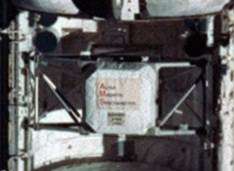Alpha Magnetic Spectrometer
| AMS-02 patch | |
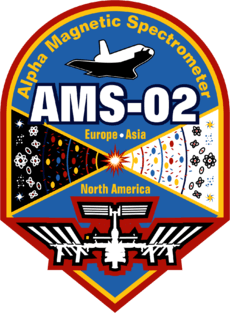 | |
| Alpha magnetic spectrometer | |
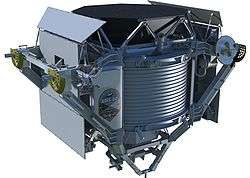 | |
| Organization | AMS Collaboration |
|---|---|
| Mission Type | Cosmic ray |
| Host Satellite | International Space Station |
| Launch | 16 May 2011 08:56:28 EDT[1][2][3] (13:56:28 UTC) |
| Launch vehicle | Space Shuttle Endeavour |
| Launch site | Kennedy Space Center LC 39A |
| Mission duration | 10 years or more[2] |
| Mission elapsed time | 5 years, 6 months and 19 days |
| Mass | 6,717 kg (14,808 lb) |
| Max length | |
| Power consumption | 2000–2500 W |
| Webpage | AMS-02 homepage |
| Orbital elements (ISS) | |
| Inclination | 51.6 degrees |
| Orbit | LEO |
| Min altitude | 341 km (184 nmi) |
| Max altitude | 353 km (191 nmi) |
| Period | ~91 minutes |
The Alpha Magnetic Spectrometer, also designated AMS-02, is a particle physics experiment module that is mounted on the International Space Station (ISS). It is designed to measure antimatter in cosmic rays and search for evidence of dark matter. This information is needed to understand the formation of the Universe. The principal investigator is Nobel laureate particle physicist Samuel Ting. The launch of Space Shuttle Endeavour flight STS-134 carrying AMS-02 took place on 16 May 2011, and the spectrometer was installed on 19 May 2011.[4][5] By April 15, 2015, AMS-02 had recorded over 60 billion cosmic ray events since its installation.[6]
In March 2013, at a seminar at CERN, Professor Samuel Ting reported that AMS had observed over 400,000 positrons, with the positron to electron fraction increasing from 10 GeV to 250 GeV. (Later results have shown a decrease in positron fraction at energies over about 275 GeV). There was "no significant variation over time, or any preferred incoming direction. These results are consistent with the positrons originating from the annihilation of dark matter particles in space, but not yet sufficiently conclusive to rule out other explanations." The results have been published in Physical Review Letters.[7] Additional data are still being collected.[7][8][9][10][11][12][13]
History
The alpha magnetic spectrometer was proposed in 1995 by MIT particle physicist Samuel Ting, not long after the cancellation of the Superconducting Super Collider. The proposal was accepted and Ting became the principal investigator.[14]
AMS-01
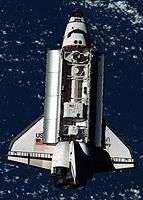
An AMS prototype designated AMS-01, a simplified version of the detector, was built by the international consortium under Ting's direction and flown into space aboard the Space Shuttle Discovery on STS-91 in June 1998. By not detecting any antihelium the AMS-01 established an upper limit of 1.1×10−6 for the antihelium to helium flux ratio[15] and proved that the detector concept worked in space. This shuttle mission was the last shuttle flight to the Mir Space Station.
AMS-02
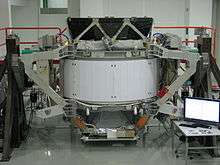
After the flight of the prototype, Ting began the development of a full research system designated AMS-02. This development effort involved the work of 500 scientists from 56 institutions and 16 countries organized under United States Department of Energy (DOE) sponsorship.
The instrument which eventually resulted from a long evolutionary process has been called "the most sophisticated particle detector ever sent into space", rivaling very large detectors used at major particle accelerators, and has cost four times as much as any of its ground-based counterparts. Its goals have also evolved and been refined over time. As it is built as a more comprehensive detector, which has a better chance of discovering evidence of dark matter along other goals.[16]
The power requirements for AMS-02 were thought to be too great for a practical independent spacecraft. So AMS-02 was designed to be installed as an external module on the International Space Station and use power from the ISS. The post-Space Shuttle Columbia plan was to deliver AMS-02 to the ISS by space shuttle in 2005 on station assembly mission UF4.1, but technical difficulties and shuttle scheduling issues added more delays.[17]
AMS-02 successfully completed final integration and operational testing at CERN in Geneva, Switzerland which included exposure to energetic proton beams generated by the CERN SPS particle accelerator.[18][19] AMS-02 was then shipped to ESA's European Space Research and Technology Centre (ESTEC) facility in the Netherlands where it arrived 16 February 2010. Here it underwent thermal vacuum, electromagnetic compatibility and electromagnetic interference testing. AMS-02 was scheduled for delivery to the Kennedy Space Center in Florida, United States. in late May 2010.[4] This was however postponed to August 26, as AMS-02 underwent final alignment beam testing at CERN.[20][21]
A cryogenic, superconducting magnet system was developed for the AMS-02. With Obama administration plans to extend International Space Station operations beyond 2015, the decision was made by AMS management to exchange the AMS-02 superconducting magnet for the non-superconducting magnet previously flown on AMS-01. Although the non-superconducting magnet has a weaker field strength, its on-orbit operational time at ISS is expected to be 10 to 18 years versus only three years for the superconducting version.[22] In January 2014 it was announced that funding for the ISS had been extended until 2024.[23]
In 1999, after the successful flight of AMS-01, the total cost of the AMS program was estimated to be $33 million, with AMS-02 planned for flight to the ISS in 2003.[24] After the Space Shuttle Columbia disaster in 2003, and after a number of technical difficulties with the construction of AMS-02, the cost of the program ballooned to an estimated $2 billion.[25][26]
Installation on the International Space Station
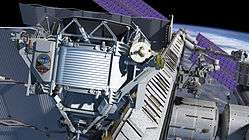
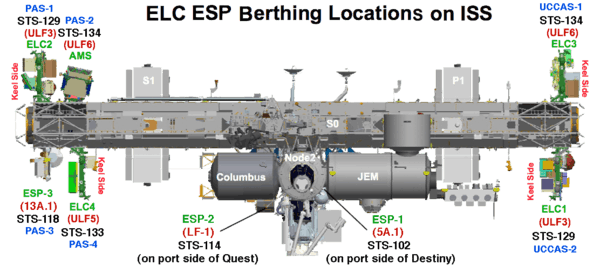
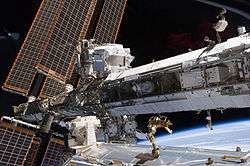
For several years it was uncertain if AMS-02 would ever be launched because it was not manifested to fly on any of the remaining Space Shuttle flights.[27] After the 2003 Columbia disaster NASA decided to reduce shuttle flights and retire the remaining shuttles by 2010. A number of flights were removed from the remaining manifest including the flight for AMS-02.[14] In 2006 NASA studied alternative ways of delivering AMS-02 to the space station, but they all proved to be too expensive.[27]
In May 2008 a bill[28] was proposed to launch AMS-02 to ISS on an additional shuttle flight in 2010 or 2011.[29] The bill was passed by the full House of Representatives on 11 June 2008.[30] The bill then went before the Senate Commerce, Science and Transportation Committee where it also passed. It was then amended and passed by the full Senate on 25 September 2008, and was passed again by the House on 27 September 2008.[31] It was signed by President George W. Bush on 15 October 2008.[32][33] The bill authorized NASA to add another space shuttle flight to the schedule before the space shuttle program was discontinued. In January 2009 NASA restored AMS-02 to the shuttle manifest. On 26 August 2010, AMS-02 was delivered from CERN to the Kennedy Space Center by a Lockheed C-5 Galaxy.[34]
It was delivered to the International Space Station on May 19, 2011 as part of station assembly flight ULF6 on shuttle flight STS-134, commanded by Mark Kelly.[35] It was removed from the shuttle cargo bay using the shuttle's robotic arm and handed off to the station's robotic arm for installation. AMS-02 is mounted on top of the Integrated Truss Structure, on USS-02, the zenith side of the S3-element of the truss.[36]
Specifications
- Mass: 8,500 kg
- Power: 2,500 W
- Internal data rate: 7 Gbit/s
- Data rate to ground: 2 Mbit/s (typical, average)[37]
- Primary mission duration: 10 to 18 years
- Magnetic field intensity: 0.15 teslas produced by a 1,200 kg permanent neodymium magnet[37]
- Original superconducting magnet: 2 coils of niobium-titanium at 1.8 K producing a central field of 0.87 teslas[38]
- AMS-02 flight magnet changed to non-superconducting AMS-01 version to extend experiment life and to solve reliability problems in the operation of the superconducting system
About 1,000 cosmic rays are recorded by the instrument per second, generating about one GB/sec of data. This data is filtered and compressed to about 300 kB/sec for download to the operation center POCC at CERN.
Design
The detector module consists of a series of detectors that are used to determine various characteristics of the radiation and particles as they pass through. Characteristics are determined only for particles that pass through from top to bottom. Particles that enter the detector at any other angles are rejected. From top to bottom the subsystems are identified as:[39]
- Transition radiation detector measures the velocities of the highest energy particles;
- Upper time of flight counter, along with the lower time of flight counter, measures the velocities of lower energy particles;
- Star tracker determines the orientation of the module in space;
- Silicon tracker measures the coordinates of charged particles in the magnetic field;
- Permanent magnet bends the path of charged particles so they can be identified;
- Anti-coincidence counter rejects stray particles that enter through the sides;
- Ring imaging Cherenkov detector measures velocity of fast particles with extreme accuracy;
- Electromagnetic calorimeter measures the total energy of the particles.
Scientific goals
The AMS-02 will use the unique environment of space to advance knowledge of the Universe and lead to the understanding of its origin by searching for antimatter, dark matter and measuring cosmic rays.[36]
Antimatter
Experimental evidence indicates that our galaxy is made of matter; however, scientists believe there are about 100–200 billion galaxies in the Universe and some versions of the Big Bang theory of the origin of the Universe require equal amounts of matter and antimatter. Theories that explain this apparent asymmetry violate other measurements. Whether or not there is significant antimatter is one of the fundamental questions of the origin and nature of the Universe. Any observations of an antihelium nucleus would provide evidence for the existence of antimatter in space. In 1999, AMS-01 established a new upper limit of 10−6 for the antihelium/helium flux ratio in the Universe. AMS-02 will search with a sensitivity of 10−9, an improvement of three orders of magnitude over AMS-01, sufficient to reach the edge of the expanding Universe and resolve the issue definitively.
Dark matter
The visible matter in the Universe, such as stars, adds up to less than 5 percent of the total mass that is known to exist from many other observations. The other 95 percent is dark, either dark matter, which is estimated at 20 percent of the Universe by weight, or dark energy, which makes up the balance. The exact nature of both still is unknown. One of the leading candidates for dark matter is the neutralino. If neutralinos exist, they should be colliding with each other and giving off an excess of charged particles that can be detected by AMS-02. Any peaks in the background positron, antiproton, or gamma ray flux could signal the presence of neutralinos or other dark matter candidates, but would need to be distinguished from poorly known confounding astrophysical signals.
Strangelets
Six types of quarks (up, down, strange, charm, bottom and top) have been found experimentally; however, the majority of matter on Earth is made up of only up and down quarks. It is a fundamental question whether there exists stable matter made up of strange quarks in combination with up and down quarks. Particles of such matter are known as strangelets. Strangelets might have extremely large mass and very small charge-to-mass ratios. It would be a totally new form of matter. AMS-02 may determine whether this extraordinary matter exists in our local environment.
Space radiation environment
Cosmic radiation during transit is a significant obstacle to sending humans to Mars. Accurate measurements of the cosmic ray environment are needed to plan appropriate countermeasures. Most cosmic ray studies are done by balloon-borne instruments with flight times that are measured in days; these studies have shown significant variations. AMS-02 will be operative on the ISS, gathering a large amount of accurate data and allowing measurements of the long term variation of the cosmic ray flux over a wide energy range, for nuclei from protons to iron. In addition to the understanding the radiation protection required for astronauts during interplanetary flight, this data will allow the interstellar propagation and origins of cosmic rays to be identified.
Results
In July 2012, it was reported that AMS-02 had observed over 18 billion cosmic rays.[40]
In February 2013, Samuel Ting acknowledged that he would be publishing the first scholarly paper in a few weeks, and that in its first 18 months of operation AMS had recorded 25 billion particle events including nearly eight billion fast electrons and positrons.[41] The AMS paper reported the positron-electron ratio in the mass range of 0.5 to 350 GeV, providing evidence about the weakly interacting massive particle (WIMP) model of dark matter.
On 30 March 2013, the first results from the AMS experiment were announced by the CERN press office.[7][8][9][10][11][12][42] The first physics results were published in Physical Review Letters on 3 April 2013.[7] A total of 6.8×106 positron and electron events were collected in the energy range from 0.5 to 350 GeV. The positron fraction (of the total electron plus positron events) steadily increased from energies of 10 to 250 GeV, but the slope decreased by an order of magnitude above 20 GeV, even though the fraction of positrons still increased. There was no fine structure in the positron fraction spectrum, and no anisotropies were observed. The accompanying Physics Viewpoint[43] said that "The first results from the space-borne Alpha Magnetic Spectrometer confirm an unexplained excess of high-energy positrons in Earth-bound cosmic rays." These results are consistent with the positrons originating from the annihilation of dark matter particles in space, but not yet sufficiently conclusive to rule out other explanations. Samuel Ting said “Over the coming months, AMS will be able to tell us conclusively whether these positrons are a signal for dark matter, or whether they have some other origin."[44]
On September 18, 2014, new results with almost twice as much data were presented in a talk at CERN and published in Physical Review Letters.[45][46][47] A new measurement of positron fraction up to 500 GeV was reported, showing that positron fraction peaks at a maximum of about 16% of total electron+positron events, around an energy of 275 ± 32 GeV. At higher energies, up to 500 GeV, the ratio of positrons to electrons begins to fall again.
AMS presented for 3 days at CERN in April 2015, covering new data on 300 million proton events and helium flux.[48]
See also
- List of space telescopes (Astronomical Space Observatories)
- Payload for Antimatter Matter Exploration and Light-nuclei Astrophysics (PAMELA) – an Italian-international cosmic ray mission launched in 2006 with similar goals
- Scientific research on the ISS
References
![]() This article incorporates public domain material from the National Aeronautics and Space Administration document "AMS project page".
This article incorporates public domain material from the National Aeronautics and Space Administration document "AMS project page".
- ↑ Moskowitz, Clara. "NASA Delays Last Launch of Shuttle Endeavour Due to Malfunction". Space.com. Retrieved 29 April 2011.
- 1 2 Final Shuttle Flight Will Be Delayed at Least Until November for AMS Switchout – April 26th, 2010
- ↑ "Space Shuttle Launch and Landing". NASA. Archived from the original on 24 May 2011. Retrieved 16 May 2011.
- 1 2 "A final test for AMS at ESTEC". The Bulletin. CERN. 22 February 2010. Retrieved 20 February 2010.
- ↑ "AMS-NASA meeting results". AMS collaboration. 18 April 2010.
- ↑ ""AMS Days at CERN" and Latest Results". AMS02.org. Retrieved 29 December 2015.
- 1 2 3 4 Aguilar, M.; Alberti, G.; Alpat, B.; Alvino, A.; Ambrosi, G.; Andeen, K.; Anderhub, H.; Arruda, L.; Azzarello, P.; Bachlechner, A.; Barao, F.; Baret, B.; Barrau, A.; Barrin, L.; Bartoloni, A.; Basara, L.; Basili, A.; Batalha, L.; Bates, J.; Battiston, R.; Bazo, J.; Becker, R.; Becker, U.; Behlmann, M.; Beischer, B.; Berdugo, J.; Berges, P.; Bertucci, B.; Bigongiari, G.; et al. (2013). "First Result from the Alpha Magnetic Spectrometer on the International Space Station: Precision Measurement of the Positron Fraction in Primary Cosmic Rays of 0.5–350 GeV". Physical Review Letters. 110 (14): 141102. Bibcode:2013PhRvL.110n1102A. doi:10.1103/PhysRevLett.110.141102.
- 1 2 Staff (3 April 2013). "First Result from the Alpha Magnetic Spectrometer Experiment". AMS Collaboration. Retrieved 3 April 2013.
- 1 2 Heilprin, John; Borenstein, Seth (3 April 2013). "Scientists find hint of dark matter from cosmos". AP News. Retrieved 3 April 2013.
- 1 2 Amos, Jonathan (3 April 2013). "Alpha Magnetic Spectrometer zeroes in on dark matter". BBC. Retrieved 3 April 2013.
- 1 2 Perrotto, Trent J.; Byerly, Josh (2 April 2013). "NASA TV Briefing Discusses Alpha Magnetic Spectrometer Results". NASA. Retrieved 3 April 2013.
- 1 2 Overbye, Dennis (3 April 2013). "New Clues to the Mystery of Dark Matter". New York Times. Retrieved 3 April 2013.
- ↑ http://home.web.cern.ch/about/updates/2013/04/ams-experiment-measures-antimatter-excess-space
- 1 2 Overbye, Dennis (3 April 2007). "Long-Awaited Cosmic-Ray Detector May Be Shelved". The New York Times.
- ↑ AMS Collaboration; Aguilar, M.; Alcaraz, J.; Allaby, J.; Alpat, B.; Ambrosi, G.; Anderhub, H.; Ao, L.; et al. (August 2002). "The Alpha Magnetic Spectrometer (AMS) on the International Space Station: Part I – results from the test flight on the space shuttle". Physics Reports. 366 (6): 331–405. Bibcode:2002PhR...366..331A. doi:10.1016/S0370-1573(02)00013-3.
- ↑ Controversy Follows Pricey Space Station Experiment to Launch Pad, SCIENCE, VOL. 332, 22 APRIL 2011
- ↑ Monreal, Benjamin. "AMS experiment mission overview". AMS Experiment Guided Tour. AMS-02 Collaboration. Retrieved 3 September 2009.
- ↑ "LEAVING CERN, ON THE WAY TO ESTEC". AMS in The News. AMS-02. February 16, 2010.
- ↑ "Dark Matter Detective Arrives At ESTEC" (PDF). Space Daily. spacedaily.com. Feb 17, 2010.
- ↑ Video on youtube of AMS being airlifted with C5 Galaxy from GVA airport on 26 August
- ↑ "Waiting for the Alpha Magnetic Spectrometer". ESA News. 17 December 2009. Archived from the original on 26 January 2010. Retrieved 9 January 2010.
- ↑ "AMS To Get Longer Lease On Life". Aviation Week and Space Technology. 23 April 2010. Archived from the original on March 26, 2012. Retrieved 23 April 2010.
- ↑ Achenbach, Joel (8 January 2014). "NASA: International space station operation extended by Obama until at least 2024". washingtonpost.com. Retrieved 19 February 2014.
- ↑ Clark, Greg (15 October 1999). "NASA Puts Big Bang to the Test". SPACE.com. Archived from the original on 3 February 2003. Retrieved 20 September 2009.
- ↑ George Musser (May 2011). "Cosmic-Ray Detector on Space Shuttle Set to Scan Cosmos for Dark Matter". Scientific American. Retrieved January 24, 2014.
- ↑ Hsu, Jeremy (2 September 2009). "Space Station Experiment to Hunt Antimatter Galaxies". Space.com. Archived from the original on 6 October 2009. Retrieved 2 September 2009.
- 1 2 Kaufman, Marc (2 December 2007). "The Device NASA Is Leaving Behind". Washington Post. Retrieved 2 December 2007.
- ↑ bill
- ↑ Iannotta, Becky (19 May 2008). "House Bill Would Authorize Additional Shuttle Flights". Space.com. Archived from the original on 20 May 2008. Retrieved 19 May 2008.
- ↑ David Kestenbaum (10 June 2008). NASA balks at Taking Physics Gear Into Space (Radio production). Washington, D.C.: National Public Radio. Retrieved 10 June 2008.
- ↑ "House Sends NASA Bill to President's Desk, Reaffirms Commitment to Balanced and Robust Space and Aeronautics Program" (Press release). House Science and Technology Committee. 27 September 2008.
- ↑ Matthews, Mark (15 October 2008). "Bush Signs NASA Authorization Act". Orlando Sentinel.
- ↑ "Major Actions: H.R. 6063". THOMAS (Library of Congress).
- ↑ CERN News – Aug 28, 2010: AMS From CERN to Space!
- ↑ "Consolidated Launch Manifest". NASA. 25 August 2009. Archived from the original on 31 August 2009. Retrieved 3 September 2009.
- 1 2 "Alpha Magnetic Spectrometer – 02 (AMS-02)". NASA. 21 August 2009. Retrieved 3 September 2009.
- 1 2 http://www.ams02.org/what-is-ams/ams-facts-figures/
- ↑ Blau, B.; Harrison, S.M.; Hofer, H.; Horvath, I.L.; Milward, S.R.; Ross, J.S.H.; Ting, S.C.C.; Ulbricht, J.; Viertel, G. (2002). "The superconducting magnet system of AMS-02 – a particle physics detector to be operated on the International Space Station". IEEE Transactions on Appiled Superconductivity. 12 (1): 349–352. doi:10.1109/TASC.2002.1018417.
- ↑ Monreal, Benjamin. "The AMS Experiment". MIT. Retrieved 3 September 2009.
- ↑ Palmer, Jason (2012-07-25). "Alpha Magnetic Spectrometer claims huge cosmic ray haul". BBC News Online. Retrieved 2013-02-18.
- ↑ Amos, Jonathan (2013-02-18). "Alpha Magnetic Spectrometer to release first results". BBC News Online. Retrieved 2013-02-18.
- ↑ "First result from the AMS experiment". CERN press office. 30 March 2013. Retrieved 3 April 2013.
- ↑ Coutu, S. (2013). "Positrons Galore". Physics. 6. Bibcode:2013PhyOJ...6...40C. doi:10.1103/Physics.6.40.
- ↑ "AMS experiment measures antimatter excess in space".
- ↑ L. Accardo; AMS Collaboration (18 September 2014). "High Statistics Measurement of the Positron Fraction in Primary Cosmic Rays of 0.5–500 GeV with the Alpha Magnetic Spectrometer on the International Space Station" (PDF). Physical Review Letters. 113: 121101. Bibcode:2014PhRvL.113l1101A. doi:10.1103/PhysRevLett.113.121101.
- ↑ "New results from the Alpha Magnetic Spectrometer on the International Space Station" (PDF). AMS-02 at NASA. Retrieved 21 September 2014.
- ↑ Schirber, Michael. "Synopsis: More Dark Matter Hints from Cosmic Rays?". American Physical Society. Retrieved 21 September 2014.
- ↑ "Physics community to discuss latest results of the AMS experiment | CERN press office". press.web.cern.ch. Retrieved 2015-07-23.
Further reading
- AMS Collaboration (2011). "Isotopic Composition of Light Nuclei in Cosmic Rays: Results from AMS-01". Astrophys. J. 736: 105. arXiv:1106.2269
 . Bibcode:2011ApJ...736..105A. doi:10.1088/0004-637X/736/2/105.
. Bibcode:2011ApJ...736..105A. doi:10.1088/0004-637X/736/2/105. - AMS Collaboration (2010). "Relative Composition and Energy Spectra of Light Nuclei in Cosmic Rays. Results from AMS-01". Astrophys. J. 724: 329–340. Bibcode:2010ApJ...724..329A. doi:10.1088/0004-637X/724/1/329.
- AMS Collaboration (2007). "Cosmic-ray positron fraction measurement from 1 to 30-GeV with AMS-01". Phys. Lett. B. 646: 145–154. arXiv:astro-ph/0703154
 . Bibcode:2007PhLB..646..145A. doi:10.1016/j.physletb.2007.01.024.
. Bibcode:2007PhLB..646..145A. doi:10.1016/j.physletb.2007.01.024. - AMS Collaboration (2005). "A study of cosmic-ray secondaries induced by the MIR Space Station using AMS-01". Nucl. Instrum. Meth. B. 234: 321–332.
- AMS Collaboration (2002). "The AMS on the ISS. Part I - Results from the test flight on the Space Shuttle". Phyiscs Reports. 366: 331–405.
- AMS Collaboration (2000). "Helium in near Earth orbit". Phys. Lett. B. 494: 193–202. Bibcode:2000PhLB..494..193A. doi:10.1016/S0370-2693(00)01193-X.
- AMS Collaboration (2000). "Cosmic Protons.". Phys. Lett. B. 490: 27–35. Bibcode:2000PhLB..490...27A. doi:10.1016/S0370-2693(00)00970-9.
- AMS Collaboration (2000). "Leptons in near earth orbit.". Phys. Lett. B. 484: 10–22. Bibcode:2000PhLB..484...10A. doi:10.1016/S0370-2693(00)00588-8.
- AMS Collaboration (2000). "Protons in near earth orbit.". Phys. Lett. B. 472: 215–226. arXiv:hep-ex/0002049
 . Bibcode:2000PhLB..472..215A. doi:10.1016/S0370-2693(99)01427-6.
. Bibcode:2000PhLB..472..215A. doi:10.1016/S0370-2693(99)01427-6. - AMS Collaboration (1999). "Search for anti-helium in cosmic rays.". Phys. Lett. B. 461: 387–396. arXiv:hep-ex/0002048
 . Bibcode:1999PhLB..461..387A. doi:10.1016/S0370-2693(99)00874-6.
. Bibcode:1999PhLB..461..387A. doi:10.1016/S0370-2693(99)00874-6.
- Sandweiss, J. (2004). "Overview of strangelet searches and Alpha Magnetic Spectrometer: when will we stop searching?". Journal of Physics G: Nuclear and Particle Physics. 30 (1): S51–S59. Bibcode:2004JPhG...30S..51S. doi:10.1088/0954-3899/30/1/004.
External links
| Wikimedia Commons has media related to Alpha Magnetic Spectrometer. |
- AMS Collaboration Homepage
- AMS Homepage at CERN. Inc. construction diagrams.
- AMS Homepage at the Johnson Space Center
- NASA AMS-02 Project Fact Sheet
- NASA AMS-02 Project Home Page with real-time cosmic ray count
- An animated movie of the STS-134 mission showing the installation of AMS-02 (72MB)
- Alpha Magnetic Spectrometer – image collection – AMS-02 on Facebook
- A Costly Quest for the Dark Heart of the Cosmos (New York Times, 16 November 2010)
